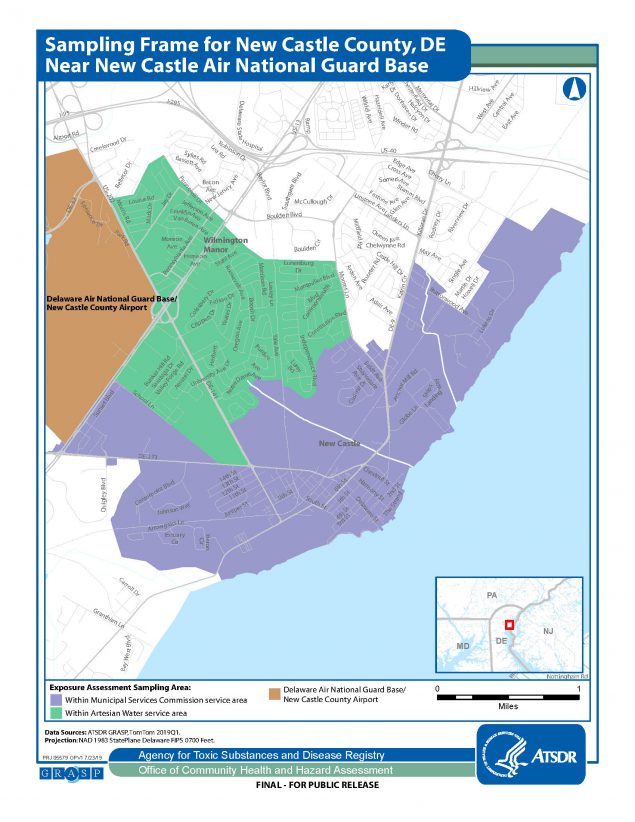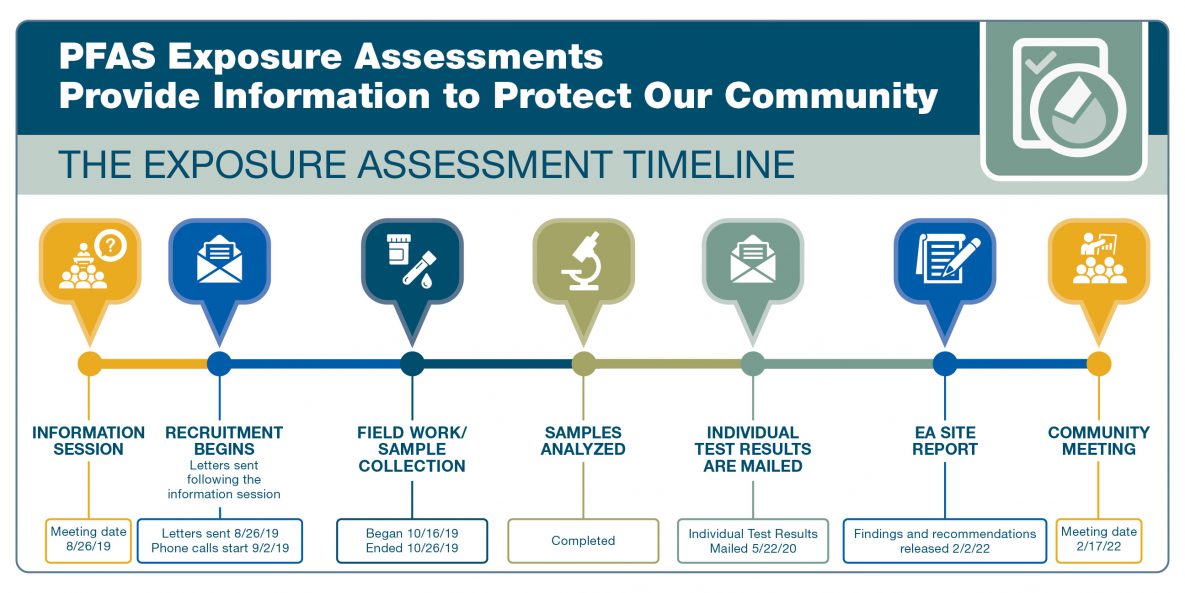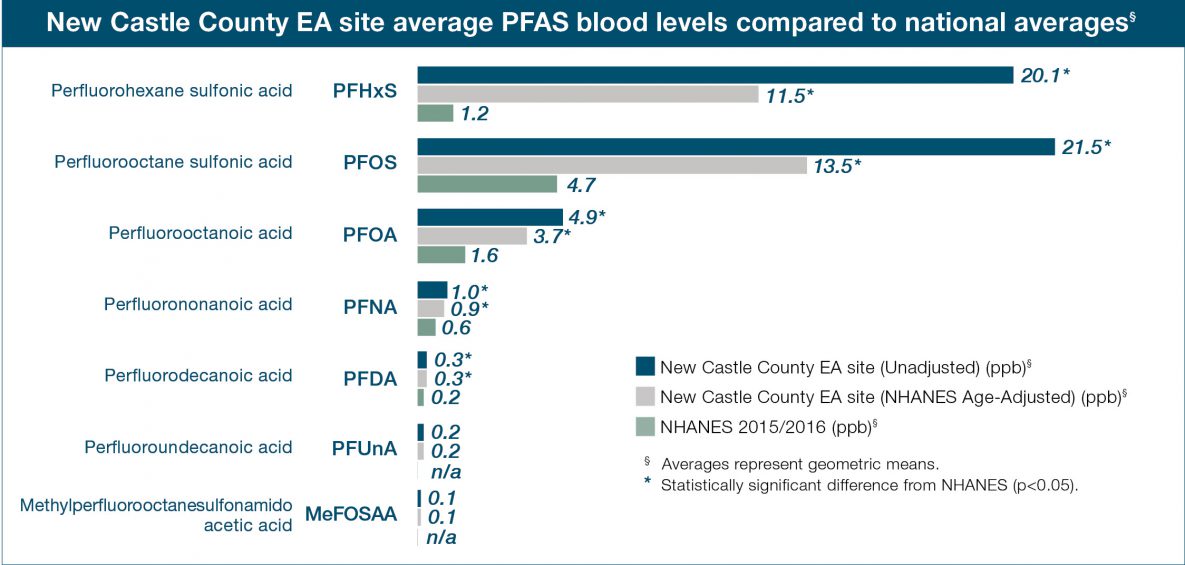New Castle County (DE) near New Castle Air National Guard Base

Background
In 2019, the Centers for Disease Control and Prevention (CDC) and the Agency for Toxic Substances and Disease Registry (ATSDR) conducted an exposure assessment (EA) from in and around the City of New Castle in New Castle County, Delaware, near New Castle Air National Guard Base. CDC/ATSDR sent the individual test results to participants and released summary results to the community in May 2020. The PFAS exposure assessment report [PDF – 3 MB] was released in February 2022.
Why did we select the New Castle County EA site?
When selecting EA sites, ATSDR considered the extent of PFOA and PFOS contamination in drinking water supplies, the duration over which exposure may have occurred, and the number of potentially affected residents. The New Castle County EA site was one of several sites nationwide identified with PFAS drinking water contamination from use of products such as aqueous film forming foam (AFFF).
The Base used AFFF containing PFAS for its firefighter training in the past. Over time, the PFAS from the AFFF entered the ground, moved into the groundwater to offsite locations, and affected nearby municipal wells. In 2014, two drinking water systems serving the New Castle area, Artesian Water and Municipal Services Commission (MSC) of the City of New Castle, were found to contain PFAS levels exceeding the Environmental Protection Agency’s (EPA) provisional health advisory (HA). Both water systems removed contaminated wells from service and upgraded their systems to reduce PFAS exposures. Both systems mitigated PFAS exposures below the provisional HA in 2014. In 2016, one additional well in Artesian’s system was found to exceed the (lower) 2016 EPA HA. Artesian took additional action to remove that well from service and reduce concentrations of PFAS in drinking water below the EPA HA. Final mitigation was achieved by MSC in August 2014 and by Artesian in July 2016.
Based on the information ATSDR has reviewed, the Artesian and MSC public drinking water supplies currently meet or are below the EPA’s 2016 HA for PFAS in drinking water. At this time, ATSDR does not recommend community members who get drinking water from the Artesian and MSC public water systems use alternative sources of water.
How was the testing conducted?
ATSDR invited randomly selected households to participate in the PFAS exposure assessment. To be eligible to participate, household residents must have
- been served by the MSC drinking water system for at least 1 year before August 5, 2014, or by the Artesian Water system at least 1 year before July 18, 2016 (these residents have the greatest likelihood of past exposures to PFAS via the drinking water supplies),
- been greater than three years old at the time of sample collection, and
- not been anemic or have a bleeding disorder that would prevent giving a blood sample.
Measuring PFAS in the blood of people from randomly selected households allows us to estimate exposure from consumption of public drinking water for the entire community in the affected area, even those who were not tested.
Results
In May 2020, CDC/ATSDR released a summary of the biological and environmental test results. The full report was released February 2, 2022 and a summary of the report’s findings is presented below. The full report is available here [PDF – 3 MB] .
ATSDR
analyzed data from
214
people, including children
(203 adults and 11 children)
from
134
households
Everyone completed a questionnaire
most people provided blood and urine samples.
The serum portion of the blood was analyzed for PFAS. ATSDR collected samples of tap water and dust from some homes.
Key Takeaways
- Levels of some PFAS in blood (detailed below) in New Castle County EA site were as much as 9.8 times higher than national levels. Other PFAS measured in blood (PFUnA and MeFOSAA) were detected at low concentrations but could not be compared to national levels.
- Elevated blood levels may be linked with past drinking water contamination.
- Some demographic and lifestyle characteristics were linked with higher PFAS blood levels.
- All tap water samples collected during the EA in 2019 met the EPA’s health advisory PFAS in drinking water.
Average blood levels of 5 PFAS (PFHxS, PFOS, PFOA, PFNA, and PFDA) in New Castle County EA participants were higher than average levels nationwide.
Of the seven PFAS tested at the New Castle County EA site, at least one PFAS was detected in all participants. And all 7 PFAS were detected in more than 60% of the blood samples collected: PFHxS, PFOS, PFOA, PFNA, PFDA, PFUnA, and MeFOSAA.
Since 1999, the National Health and Nutrition Examination Survey (NHANES) has measured PFAS levels in blood in the U.S. population, and PFAS levels are shown to be age dependent. In its analysis, ATSDR adjusted blood levels of EA participants at the New Castle County EA site for age to enable meaningful comparison to the NHANES dataset. After adjusting for the effects of age, PFHxS, PFOA, PFOS, PFNA and PFDA were all elevated compared to levels nationwide. Age-adjusted averages are more representative the New Castle County EA site community.County EA site community.
* ATSDR initially reported average blood levels of three PFAS (PFHxS, PFOA, and PFOS) above national averages, after statistical analyses levels of five PFAS (PFHXs, PFOS, PFOA, PFNA, and PFDA) were found to be higher.
Elevated blood levels of PFHxS, PFOS, and PFOA in the New Castle County EA participants may be linked with past contamination of the drinking water systems.
Three PFAS (PFHxS, PFOS, and PFOA) were detected in the MSC system in 2009 and in the Artesian Water system in 2014. We do not know if PFAS contamination began earlier, because data are not available before 2009 for the MSC system and 2014 for the Artesian Water system.
In 2014, the MSC water supply system mitigated the contamination. The Artesian water supply system took similar action in 2014. In 2016, an additional well was found to be contaminated above the 2016 EPA HA so final mitigation in the Artesian system was not completed until 2016. PFAS have long half-lives in the human body. Therefore, even though drinking water exposures were reduced 3 to 5 years before the collection of EA blood samples, past drinking water exposures were a likely contributing factor to the EA participants’ elevated blood PFAS levels.
Generally, participants who had elevated PFHxS blood levels also had elevated PFOS and PFOA blood levels. This suggests a common source of exposure, such as the drinking water supply. Other sources of exposure were not measured but could have contributed to blood PFAS concentrations of the EA participants.
Adults who lived in the MSC service area had higher blood levels than those in the Artesian Water service area.
The differences in participants’ PFAS blood levels between the two water systems were consistent with the historic levels of PFAS in the drinking water, i.e., higher historical PFAS levels in MSC public water.
Long-time residents have higher PFHxS, PFOS, and PFOA blood levels
(for either MSC or Artesian users).
Adults who used at least one water filter or treatment device had lower PFHxS, PFOS, and PFOA blood levels compared to those who did not
(for either MSC or Artesian users).
Males had 28% higher blood levels of PFOS than females.
Adults who reported a
history of kidney disease had 56% higher PFHxS blood levels than those who did not report kidney disease.
Adults who reported
cleaning their homes an average of 3+ times per week had 42% lower PFHxS and 34% lower PFOS blood levels than adults who reported cleaning a few times per month or less.
Fact sheets and Report
- PFAS Exposure Assessment, New Castle County, DE: Fact Sheet [PDF – 243 KB]
- PFAS Exposure Assessment, New Castle County, DE: Community-Level Summary Results Fact Sheet [PDF – 94 KB]
- PFAS Exposure Assessment, New Castle County, DE: Report [PDF – 3 MB]
- PFAS Exposure Assessment, New Castle County, DE: Report Appendix [PDF – 3 MB]
- PFAS Exposure Assessment, New Castle County, DE: Report Consumer Summary [PDF – 360 KB]
CDC and ATSDR invite residents living in and around the City of New Castle to attend a virtual information session to learn more about the results of the PFAS exposure assessment. Experts will also answer community questions.
When
February 17, 2022
Time
6:00-7:30 PM ET
To register, go to: https://bit.ly/NewCastleEAMtg
ATSDR staff is also hosting small online meetings to answer community questions. Sign up here: https://bit.ly/NewCastleEASmallMtg


